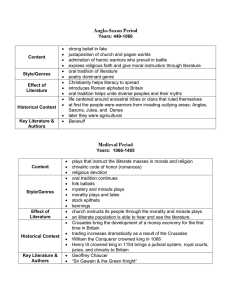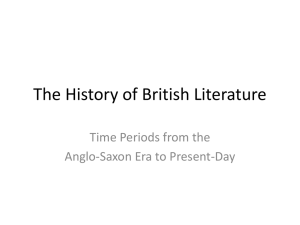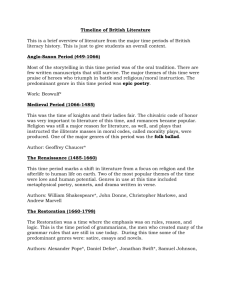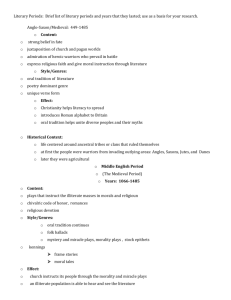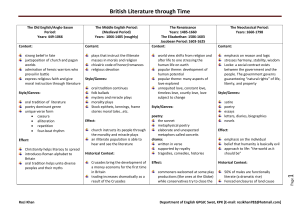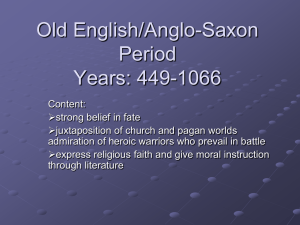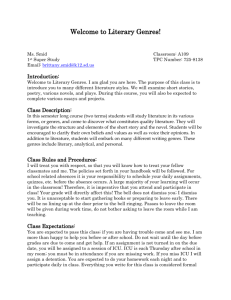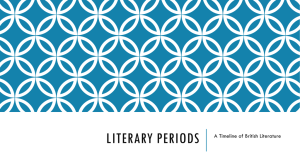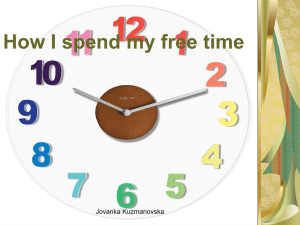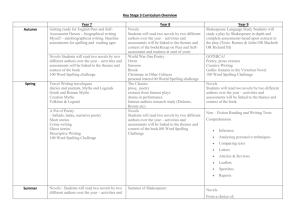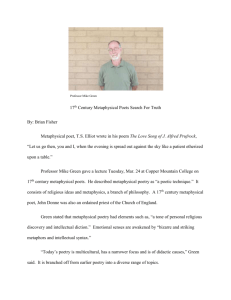British Literature Timeline: Periods & Authors
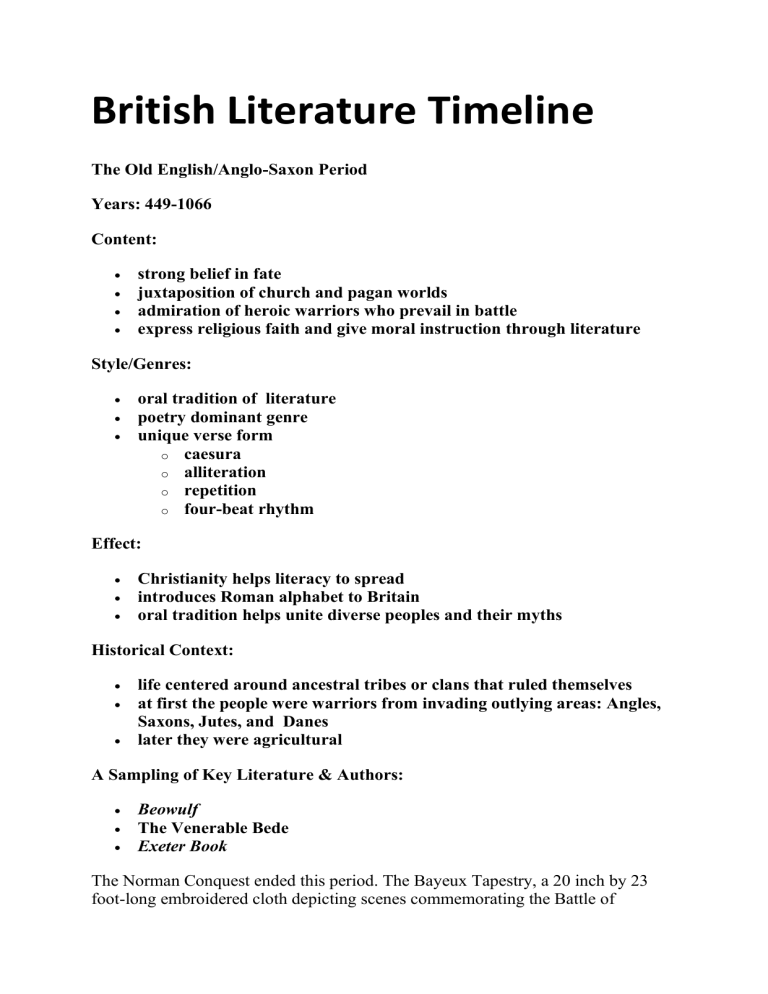
British Literature Timeline
The Old English/Anglo-Saxon Period
Years: 449-1066
Content:
strong belief in fate
juxtaposition of church and pagan worlds
admiration of heroic warriors who prevail in battle express religious faith and give moral instruction through literature
Style/Genres:
oral tradition of literature
poetry dominant genre unique verse form o caesura o o o alliteration repetition four-beat rhythm
Effect:
Christianity helps literacy to spread introduces Roman alphabet to Britain oral tradition helps unite diverse peoples and their myths
Historical Context:
life centered around ancestral tribes or clans that ruled themselves at first the people were warriors from invading outlying areas: Angles,
Saxons, Jutes, and Danes later they were agricultural
A Sampling of Key Literature & Authors:
Beowulf
The Venerable Bede
Exeter Book
The Norman Conquest ended this period. The Bayeux Tapestry, a 20 inch by 23 foot-long embroidered cloth depicting scenes commemorating the Battle of
Hastings in 1066, was probably commissioned ca 1070 to tell the story of William the Conqueror and Harold, Earl of Wessex, the men who led the Norman and
Saxon armies in 1066. William's defeat of Harold at the Battle of Hastings ensured the success of the Norman invasion of England. Follow this link to read the story and to see sections of the tapestry.
The Middle English Period (Medieval Period)
Years: 1066-1485 (roughly)
Content:
plays that instruct the illiterate masses in morals and religioun
chivalric code of honor/romances religious devotion
Style/Genres:
oral tradition continues
folk ballads
mystery and miracle plays
morality plays
tock epithets
kennings
frame stories
moral tales
Effect:
church instructs its people through the morality and miracle plays an illiterate population is able to hear and see the literature
Historical Context:
Crusades bring the development of a money economy for the first time
in Britain
trading increases dramatically as a result of the Crusades
William the Conqueror crowned king in 1066
Henry III crowned king in 1154 brings a judicial system, royal courts, juries, and chivalry to Britain
A Sampling of Key Literature & Authors:
Sir Gawain and the Green Knight, Pearl
Domesday Book
L’Morte de Arthur
Geoffrey Chaucer
The Renaissance
Years: 1485-1660
The Elizabethan Period: the reign of Elizabeth I, 1586-1603
Jacobean Period: he reign of James I of England, 1603-1625
Content:
world view shifts from religion and after life to one stressing the human life on earth
popular theme: development of human potential
popular theme: many aspects of love explored
unrequited love
constant love
timeless love
courtly love
love subject to change
Style/Genres:
poetry o the sonnet o metaphysical poetry
elaborate and unexpected metaphors called conceits drama o o o written in verse supported by royalty tragedies, comedies, histories
Effect:
commoners welcomed at some play productions (like ones at the Globe) while conservatives try to close the theaters on grounds that they promote brazen behaviors not all middle-class embrace the metaphysical poets and their abstract conceits
Historical Context:
War of Roses ends in 1485 and political stability arrives
Printing press helps stabilize English as a language and allows more people to read a variety of literature
Economy changes from farm-based to one of international trade
A Sampling of Key Literature & Authors:
William Shakespeare
Thomas Wyatt
Ben Jonson
Cavalier Poets
Metaphysical Poets
John Donne
Christopher Marlowe
Andrew Marvell
Robert Herrick
Katherine Phillips
The Neoclassical Period ;
Years: 1660-1798
The Restoration: the reign of Charles II, 1630 - 1660 (after his restoration to the thrown in 1630 following the English Civil War and Cromwell)
The Age of Enlightenment (the Eighteenth Century)
Content:
emphasis on reason and logic stresses harmony, stability, wisdom
Locke: a social contract exists between the government and the people.
The government governs guaranteeing “natural rights” of life, liberty, and property
Style/Genres:
satire
poetry
essays letters, diaries, biographies novels
Effect:
emphasis on the individual belief that humanity is basically evil approach to life: “the world as it should be”
Historical Context:
50% of males are functionally literate (a dramatic rise)
Fenced enclosures of land cause demise of traditional village life
Factories begin to spring up as industrial revolution begins
Impoverished masses begin to grow as farming life declines and
factories build
Coffee houses—where educated men spend evenings with literary and political associates
A Sampling of Key Literature & Authors:
Alexander Pope
Daniel Defoe
Jonathan Swift,
Samuel Johnson
John Bunyan
John Milton
The Romantic Period
Years: 1798 – 1832
Content:
human knowledge consists of impressions and ideas formed in the individual’s mind introduction of Gothic elements and terror/horror stories and novels in nature one can find comfort and peace that the man-made urbanized towns and factory environments cannot offer
Style/Genres:
poetry o lyrical ballads
Effects:
evil attributed to society not to human nature human beings are basically good
movement of protest: a desire for personal freedom children seen as hapless victims of poverty and exploitation
Historical Context:
Napoleon rises to power in France and opposes England militarily and economically gas lamps developed
Tory philosophy that government should NOT interfere with private enterprise middle class gains representation in the British parliament railroads begin to run
Key Literature/Authors:
Novelists
o o
Poets
Jane Austen
Mary Shelley o o o o o o o
Robert Burns
William Blake
William Wordsworth
Samuel Taylor Coleridge
Lord Byron
Percy Shelley
John Keats
The Victorian Period
Years: 1832-1900
Content:
conflict between those in power and the common masses of laborers and
the poor shocking life of sweatshops and urban poor is highlighted in literature to insist on reform
country versus city life
sexual discretion (or lack of it)
strained coincidences
romantic triangles
heroines in physical danger aristocratic villains misdirected letters
bigamous marriages
Genres/Styles:
novel becomes popular for first time; mass produced for the first time o bildungsroman o political novels
o o elegies detective novels (Sherlock Holmes) serialized novels (Charles Dickens)
poetry: easier to understand o dramatic monologues
drama: comedies of manners
magazines offer stories to the masses
Effect:
literature begins to reach the masses
Historical Context:
paper becomes cheap; magazines and novels cheap to mass produce unprecedented growth of industry and business in Britain unparalleled dominance of nations, economies and trade abroad
Key Literature/Authors:
Charles Dickens
Thomas Hardy
Rudyard Kipling
Robert Louis Stevenson
George Eliot
Oscar Wilde
Alfred Lord Tennyson
Charles Darwin
Charlotte Bronte
Robert Browning
The Modern Period
Years: 1900-(subject to debate)
Content:
Genres/Styles:
poetry: free verse
epiphanies begin to appear in literature
speeches
memoirs novels o stream of consciousness
Effect:
Historical Context:
British Empire loses 1 million soldiers to World War I
Winston Churchill leads Britain through WW II, and the Germans
bomb England directly
British colonies demand independence
A Sampling of Key Literature and Authors:
James Joyce
Virginia Woolf
T. S. Eliot
Joseph Conrad
D. H. Lawrence
Graham Greene
Dylan Thomas
George Orwell
William Butler Yeats
Bernard Shaw
